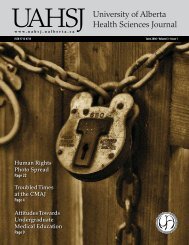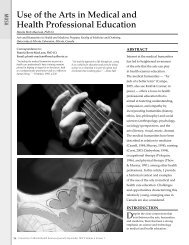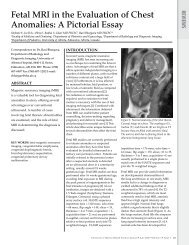REVIEWIn the event a patient demands a skinbiopsy, it may be worthwhile to do onerather than risk losing rapport with thepatient. Koo and Lee (2001) suggest makinga verbal agreement beforehand, and thatthe patient be more flexible in his or herthinking if the biopsy returns negative; thismay make it easier to convince the patientto take antipsychotic medications afterthe biopsy. 8 When antipsychotic therapyis initiated, it is advisable to <strong>of</strong>fer themedication as an empirical therapy whileemphasizing the potential for reductionin symptoms, like biting and crawlingsensations. 8 Potential side effects <strong>of</strong> theantipsychotics should be discussed withthe patient beforehand, to enhance patientcompliance. Considering the patient’s comorbiditieswhen selecting the particularantipsychotic to be used can help tailorthe choice; for example, in a patient withdiabetes, olanzapine should be avoideddue to its potential for metabolic syndromeside effects. Depot injections (risperidone)should only be pursued as an optionif the patient is willing to be regularlymonitored by a psychiatric team. Workingin conjunction with the patient’s familyphysician to monitor both the side effects <strong>of</strong>the antipsychotic medication and course <strong>of</strong>the DP will reduce the risks <strong>of</strong> complicationsfrom the therapy, especially if the patientrefuses the involvement <strong>of</strong> psychiatry.CONCLUSIONThere has never been a randomizedcontrol trial directly comparing atypicalantipsychotics to typical antipsychotics,which would be useful in establishing aclear treatment <strong>of</strong> choice for DP. 10 However,based on the efficacy <strong>of</strong> drugs in bothclasses as shown in Tables 1 and 2, it wouldappear that atypical antipsychotics have alower side effect pr<strong>of</strong>ile while achieving apartial to full remission rate similar to typicalantipsychotics. The reduction in adverseiatrogenic events would improve patientcompliance to treatment and help constructa therapeutic relationship between thepatient and physician.References:1. Wilson FC, Uslan DZ. Delusionalparasitosis. Mayo Clin Proc. 2004;79:1470.2. Wilson J, Miller H. Delusions <strong>of</strong> Parasitosis.Archives <strong>of</strong> Dermatology and Syphilology.1946;54:39-56.3. Boggild AK, Nicks BA, Yen L, VanVoorhis W, McMullen R, Buckner FS,et al. Delusional parasitosis: six-yearexperience with 23 consecutive cases at anacademic medical center. Int J Infect Dis.2010;14:e317-21.4. DSM-IV-TR. Diagnostic and statisticalmanual <strong>of</strong> mental health disorders (4thed, text revision). In. Washington DC:American Psychiatric Association, 2000.5. Huber M, Kirchler E, Karner M,Pycha R.Delusional parasitosis and the dopaminetransporter. A new insight <strong>of</strong> etiology? MedHypotheses. 2007;68:1351-8.6. Donabedian H. Delusions <strong>of</strong> Parasitosis.Clin Infect Dis. 2007;45:e131-4.7. Driscoll MS, Rothe MJ, Grant-KelsJM, Hale MS. Delusional parasitosis:a dermatologic, psychiatric, andpharmacologic approach. J Am AcadDermatol. 1993; 29:1023-33.8. Koo J, Lee CS. Delusions <strong>of</strong> parasitosis.A dermatologist’s guide to diagnosis andtreatment. Am J Clin Dermatol. 2001;2:285-90.9. Robles DT, Romm S, Combs H, OlsonJ, Kirby P. Delusional disorders indermatology: a brief review. DermatolOnline J. 2008;14:2.10. Lepping P, Russell I, Freudenmann RW.Antipsychotic treatment <strong>of</strong> primarydelusional parasitosis: systematic review. BrJ Psychiatry. 2007;191:198-205.11. Lorenzo CR, Koo J. Pimozide indermatologic practice: a comprehensivereview. Am J Clin Dermatol. 2004;5:339-49.12. Elmer KB, George RM, Peterson K.Therapeutic update: use <strong>of</strong> risperidonefor the treatment <strong>of</strong> monosymptomatichypochondriacal psychosis. J Am AcadDermatol. 2000;43:683-6.13. Ungvari G, Vladar K. Pimozide treatmentfor delusion <strong>of</strong> infestation. Act Nerv Super(Praha). 1986;28:103-7.14. Opler LA, Feinberg SS. The role <strong>of</strong>pimozide in clinical psychiatry: a review. JClin Psychiatry. 1991;52:221-33.15. Hamann K, Avnstorp C. Delusions <strong>of</strong>infestation treated by pimozide: a doubleblindcrossover clinical study. Acta DermVenereol. 1982;62:55-8.16. Zomer SF, De Wit RF, Van Bronswijk JE,Nabarro G,Van Vloten WA. Delusions <strong>of</strong>parasitosis. A psychiatric disorder to betreated by dermatologists? An analysis <strong>of</strong>33 patients. Br J Dermatol. 1998;138:1030-2.17. Lyell A. The Michelson Lecture. Delusions<strong>of</strong> parasitosis. Br J Dermatol. 1983;108:485-99.18. Bhatia MS, Jagawat T, Choudhary S.Delusional parasitosis: a clinical pr<strong>of</strong>ile. IntJ Psychiatry Med. 2000;30:83-91.19. Lindskov R, Baadsgaard O. Delusions <strong>of</strong>infestation treated with pimozide: a followupstudy. Acta Derm Venereol. 1985;65:267-70.20. Meltzer HY. What’s atypical about atypicalantipsychotic drugs? Curr Opin Pharmacol.2004;4:53-7.21. Kapur S, Remington G. DopamineD(2) receptors and their role in atypicalantipsychotic action: still necessary andmay even be sufficient. Biol Psychiatry.2001;50:873-83.22. Westerink BH. Can antipsychotic drugs beclassified by their effects on a particulargroup <strong>of</strong> dopamine neurons in the brain?Eur J Pharmacol. 2002;455:1-18.23. Gallucci G, Beard G. Risperidone andthe treatment <strong>of</strong> delusions <strong>of</strong> parasitosisin an elderly patient. Psychosomatics.1995;36:578-80.24. De Leon OA, Furmaga KM, CanterburyAL, Bailey LG. Risperidone in thetreatment <strong>of</strong> delusions <strong>of</strong> infestation. Int JPsychiatry Med. 1997;27:403-9.25. Healy R, Taylor R, Dhoat S, LeschynskaE, Bewley AP. Management <strong>of</strong> patientswith delusional parasitosis in a jointdermatology/ liaison psychiatry clinic. Br JDermatol. 2009; 161:197-9.26. Kenchaiah BK, Kumar S, Tharyan P.Atypical anti-psychotics in DelusionalParasitosis: a retrospective case series <strong>of</strong> 20patients. Int J Dermatol. 2010; 45:95-100.27. Wenning MT, Davy LE, Catalano G,Catalano MC. Atypical antipsychotics inthe treatment <strong>of</strong> delusional parasitosis.Ann Clin Psychiatry. 2003;15:233-9.28. Nicolato R, Correa H, Romano-Silva MA,Teixeira AL, Jr. Delusional parasitosis orEkbom syndrome: a case series. Gen HospPsychiatry. 2006;28:85-7.29. Shah A, Pervez M. Risperidone LongActing Injection (RLAI) in DelusionalParasitosis. German <strong>Journal</strong> <strong>of</strong> Psychiatry.2009;12:35-7.30. Rocha FL,Hara C. Aripiprazole indelusional parasitosis: Case report. ProgNeuropsychopharmacol Biol Psychiatry.2007;31:784-6.31. Bennassar A, Guilabert A, Alsina M, PintorL,Mascaro JM, Jr. Treatment <strong>of</strong> delusionalparasitosis with aripiprazole. ArchDermatol. 2009;145:500-1.32. Sandoz A, LoPiccolo M, Kusnir D, TauskFA. A clinical paradigm <strong>of</strong> delusions<strong>of</strong> parasitosis. J Am Acad Dermatol.2008;59:698-704.33. Freudenmann RW, Kuhnlein P, LeppingP,Schonfeldt-Lecuona C. Secondarydelusional parasitosis treated withpaliperidone. Clin Exp Dermatol.2009;34:375-7.34. Freudenmann RW, Lepping P. Secondgenerationantipsychotics in primary andsecondary delusional parasitosis: outcomeand efficacy. J Clin Psychopharmacol.2008;2:500-8.12<strong>University</strong> <strong>of</strong> <strong>Alberta</strong> <strong>Health</strong> <strong>Sciences</strong> <strong>Journal</strong> • April 2012 • Volume 7 • <strong>Issue</strong> 1
35. Wyk<strong>of</strong>f RF. Delusions <strong>of</strong> parasitosis: areview. Rev Infect Dis. 1987;9:433-7.36. Milia A, Mascia MG, Pilia G, ParibelloA, Murgia D, Cocco E, et al. Efficacyand safety <strong>of</strong> quetiapine treatment fordelusional parasitosis: experience in anelderly patient. Clin Neuropharmacol.2008;31:310-2.37. Narayan V, Ashfaq M, Haddad PM.Aripiprazole in the treatment <strong>of</strong> primarydelusional parasitosis. Br J Psychiatry.2008;193:258.REVIEWStem cells in cardiac repair: A review <strong>of</strong> the changinglandscape <strong>of</strong> cardiovascular medicineNicholas A. Avdimiretz, BScMedical Student (2013), Faculty <strong>of</strong> Medicine and Dentistry <strong>University</strong> <strong>of</strong> <strong>Alberta</strong>, Edmonton, CanadaCorrespondence to Nicholas Avdimiretz: Email: naa1@ualberta.caAbstractCardiac disease is the leading cause <strong>of</strong> deathfor both men and women in developedcountries. In Canada, the incidence <strong>of</strong>diabetes and hypertension has recentlyincreased by 90% in middle income groups,resulting in substantially more cardiacdisease. How can medical pr<strong>of</strong>essionalskeep up with these statistics? Imagine ifphysicians could regenerate the woundedheart post-myocardial infarction, or evenbioengineer an entirely new organ. Thisis the future <strong>of</strong> cardiovascular medicine.Regenerating myocardium is hardly an easyundertaking; the heart contains about 20million cardiomyocytes per gram <strong>of</strong> tissue,meaning – in the left ventricle alone – thereare approximately 4 billion cardiomyocytesat risk during a heart attack. Many cells arerequired to replace damaged tissue, makingcomplete regeneration challenging. In light<strong>of</strong> the rich therapeutic potential seen inboth adult and embryonic stem cells, it is nosurprise that biomedical research on thesecells has seen an intense amount <strong>of</strong> activityin the past decade. From fetal-derivedcardiomyocytes and skeletal myoblasts, tobone marrow stromal cells and peripheralblood CD34 + cells, a myriad <strong>of</strong> cell lineshave been tested to date. The last decadehas seen an explosion <strong>of</strong> novel approachesusing these cells to restore cardiac functionpost-infarction: from developing cell-basedpacemakers and cardiac grafts, to buildingbioartifical hearts. This review will paint apicture <strong>of</strong> the rapidly changing landscape<strong>of</strong> cardiovascular medicine by elaboratingon these new technologies. Limitations<strong>of</strong> these approaches will be discussed, aswell as future developments. In the field <strong>of</strong>cell-based cardiac repair, the possibilitiesseem endless.PreambleCardiac disease is the leading cause<strong>of</strong> death for both men and women indeveloped countries. In fact, cardiovasculardisease – including coronary heart disease,hypertension, stroke, and congestive heartfailure – has ranked as the number onecause <strong>of</strong> death in the US every year since1900, except during the 1918 influenzaepidemic. 1 In 2007, heart disease accountedfor 26% <strong>of</strong> all deaths in the US, resultingin an age-adjusted death rate <strong>of</strong> 211 per100,000 people. 2 Also shocking is the cost<strong>of</strong> medication, health care services, and lostproductivity due to heart disease in the US:a projected $508 billion in 2010. 3 This costis not expected to decrease any time soon.In Canada, the incidence <strong>of</strong> risk factors forcardiac disease has increased substantiallyover the past decade: both diabetes andhypertension have increased by 90% inmiddle income groups (roughly 50% <strong>of</strong>the population), 4 resulting in substantiallymore cardiovascular disease. What if thereexisted a therapeutic technique to treat thatwhich physicians have for so long deemedincurable? What if one could regenerate thewounded heart after a myocardial infarctionusing stem cells? Imagine if one couldbioengineer a new heart. This could be thefuture <strong>of</strong> cardiovascular medicine.Over the last decade, the utilization <strong>of</strong>stem cells to repair the damaged heart hasseen an explosion <strong>of</strong> advancements. Noveltherapeutic techniques will be addressed indetail: the methods used and the resultingapplications <strong>of</strong> these innovations will bedescribed. Limitations <strong>of</strong> these techniquesand future developments will also bereviewed.Introduction to Cardiac RepairCell therapy has experienced muchgrowth over the last 25-30 years: fromits first applications for reconstitutingthe immune system after a bone marrowtransplant, to treating diabetes withpancreatic islet transplantation. 5 More recenttreatments include those for liver cirrhosis,Huntington’s disease, and Parkinson’sdisease. 6 As for heart disease, the majority<strong>of</strong> therapies have been centered on thetreatment <strong>of</strong> heart damage post-myocardialinfarction (MI). How can myocardial repairoccur in an organ that is thought to beincapable <strong>of</strong> naturally self-repairing itself?The heart does not experience regenerationas the liver does; following MI, scar tissueforms over the infarcted area. Therefore,much <strong>of</strong> the research has been gearedtowards using cell-based approaches toregenerate myocardium directly fromdonor stem cells. Regenerating heartmuscle following an MI is hardly an easyundertaking; the myocardium containsabout 20 million cardiomyocytes per gram <strong>of</strong>tissue, so there are approximately 4 billioncardiomyocytes at risk in the left ventriclealone during a heart attack. Assumingthat any repair therapy restores at least1/2 to 2/3 <strong>of</strong> the damaged myocardium,true regeneration would require 500 to 800million cells. 7 In light <strong>of</strong> the therapeuticpotential seen in both adult and embryonicstem cells (coined ES cells by Martin in1981), 8 it is no surprise that biomedicalresearch on these cells has seen an intenseamount <strong>of</strong> activity in the past decade.Stem Cell SourcesStem cells not only have an unlimitedcapacity to self-renew, but they are alsopluripotent; this means that stem cellscan be induced to differentiate into cells<strong>University</strong> <strong>of</strong> <strong>Alberta</strong> <strong>Health</strong> <strong>Sciences</strong> <strong>Journal</strong> • April 2012 • Volume 7 • <strong>Issue</strong> 1 13






